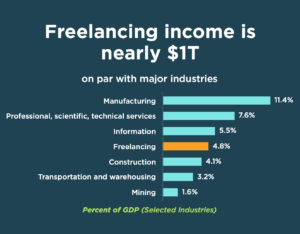Since 2014, Upwork and Freelancers Union have published “Freelancing in America,” about the country’s independent workforce. The just-released 2019 report sheds light on the direction of independent workers for the past few years. We don’t yet know what the impacts of COVID-19 on freelancing will be. But it is a worthwhile look at part of the labor force that many once was just a stopgap, but is a major economic force.
Freelancing makes up nearly 5% of GDP. In 2019, freelancers earned nearly $1 trillion, contributing more to the economy than the construction, transportation, and mining industries. These numbers demonstrate that economic policies must address the needs of the independent workforce. This is even more important during times of crisis such as what we are currently facing.
Half of freelancers view freelancing as a long-term career, while the other half see it as temporary. The first year of this report, less than 20 percent of participants thought of freelancing as a long-term occupation. As the economy improved and more jobs became available, those who remained as freelancers in 2019 did so by choice. This year, with unemployment skyrocketing, it’s very possible that many more workers will opt to freelance as a necessity.
Nearly half of freelancers (46%) said they could not have a traditional job due to personal circumstances – including health issues, disability, or caregiving responsibilities. A large share of freelancers has been able to thrive thanks to the flexibility of this career path. However, the economy slowed to a halt through the pandemic. Now, those who are unable to seek traditional employment are seeing their livelihoods threatened and will need support to stay afloat.
Freelancing is a skilled and high-earning workforce. In 2019, providing skilled services such as IT, design, or writing comprised 45% of the independent workforce. They also earned a median hourly rate of $28 – higher than the 70th percentile of overall workers. These numbers are likely to change dramatically in 2020 as jobs dry up. It’s possible freelancers will have to lower their rates in order to remain competitive.
Overall, the data from this report shows that, as the economy improved and the job market tightened, the independent workforce gained strength and value. We will see how this changes after 2020 and the effects of the pandemic reverse the economic trends of the past few years. Many people in traditional employment will turn to freelancing out of necessity. Full-time freelancers, meanwhile, may find themselves without enough work or income to make ends meet. It is imperative that public officials and economic development organizations do not overlook independent workers when planning and implementing recovery efforts.

